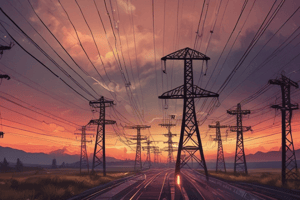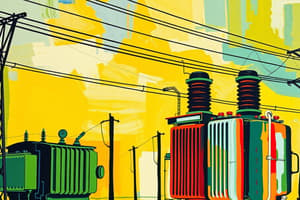Podcast
Questions and Answers
A step-up transformer decreases the voltage from primary to secondary.
A step-up transformer decreases the voltage from primary to secondary.
False (B)
Solar power plants use turbines to generate electricity.
Solar power plants use turbines to generate electricity.
False (B)
Transmission lines only carry alternating current in an electric power system.
Transmission lines only carry alternating current in an electric power system.
False (B)
Electric transmission and distribution are not important to our everyday life.
Electric transmission and distribution are not important to our everyday life.
Power plants convert electrical energy into mechanical energy.
Power plants convert electrical energy into mechanical energy.
Electric current is only carried by overhead lines, not underground lines.
Electric current is only carried by overhead lines, not underground lines.
Transmission lines are operated at relatively low voltages in order to transmit large quantities of power over long distances.
Transmission lines are operated at relatively low voltages in order to transmit large quantities of power over long distances.
Substations are used to switch generators, equipment, and circuits or lines in and out of a system, and to change AC voltages from one level to another, and/or change alternating current to direct current or direct current to alternating current.
Substations are used to switch generators, equipment, and circuits or lines in and out of a system, and to change AC voltages from one level to another, and/or change alternating current to direct current or direct current to alternating current.
An electric consumer is any person, state agency, or federal agency, to which electric energy is sold for purposes of resale.
An electric consumer is any person, state agency, or federal agency, to which electric energy is sold for purposes of resale.
Transmission power lines carry bulk electricity from the generating power station to a number of substations, and they are typically operated at voltages between 60 kV and 500 kV.
Transmission power lines carry bulk electricity from the generating power station to a number of substations, and they are typically operated at voltages between 60 kV and 500 kV.
Transmission lines are thinner compared to distribution lines.
Transmission lines are thinner compared to distribution lines.
Transmission power lines are uni-directional, allowing electricity to travel in only one direction.
Transmission power lines are uni-directional, allowing electricity to travel in only one direction.
Flashcards are hidden until you start studying
Study Notes
Power Plant
- A power plant is an industrial facility that generates electricity from primary energy.
- Most power plants use one or more generators to convert mechanical energy into electrical energy.
- The exception is solar power plants, which use photovoltaic cells to generate electricity.
Transformer
- A transformer that increases voltage from primary to secondary is called a step-up transformer.
- A transformer that decreases voltage from primary to secondary is called a step-down transformer.
Transmission Lines
- Transmission lines carry electric energy from one point to another in an electric power system.
- They can carry alternating current (AC) or direct current (DC), or a combination of both.
- Electric current can be carried by either overhead or underground lines.
- Transmission lines operate at relatively high voltages, transmit large quantities of power, and transmit power over large distances.
Substation
- A substation is a high-voltage electric system facility.
- It is used to switch generators, equipment, and circuits or lines in and out of a system.
- It is also used to change AC voltages from one level to another, and/or change AC to DC or DC to AC.
Electric Consumer
- An electric consumer means any person, state agency, or federal agency that buys electric energy for use, not for resale.
Transmission and Distribution Lines
- Transmission power lines carry bulk electricity from the generating power station to substations.
- Key features of transmission power lines include:
- Carrying electricity over long distances (across the state).
- Transporting bulk electricity at higher voltages (typically between 60 kV and 500 kV).
- Being bi-directional, allowing electricity to travel in both directions.
- Being thicker compared to distribution lines.
Studying That Suits You
Use AI to generate personalized quizzes and flashcards to suit your learning preferences.



